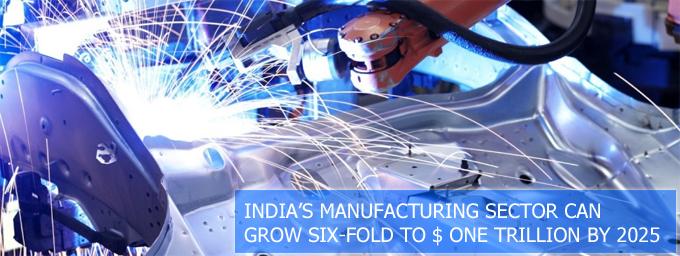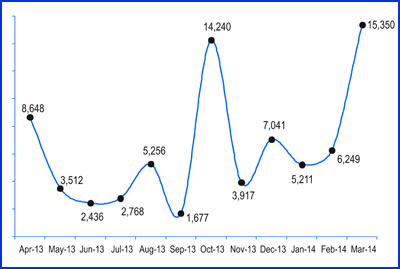|
India’s manufacturing sector has shown some signs of recovery in March 2014, with positive growth in macro-economic indicators.

HSBC's manufacturing Purchasing Managers' Index (PMI) for India, which gauges the business activity of India's factories, remained above the waterline at 51.3 in March 2014, indicating positive growth. A PMI reading above 50 indicates growth, while a lower reading means contraction. The PMI was however, down from February’s one-year high of 52.5 owing to a decline in new order inflows and a shortage of raw materials.
To make the story a little more rosy, the Indian manufacturing sector also saw its exports rising in March. The latest export figures were the highest since April 2011. Overall, activity in the manufacturing sector expanded for the fifth consecutive month in March. The manufacturing PMI for the fourth quarter of 2013-14 (FY14) was the highest in this fiscal. Manufacturing PMI for the first three quarters of FY14 was 50.5, 49.4 and 50.5, respectively.
|
|
Manufacturing Projex FY14 (In Rs Crore) |
 |
The overall recovery is supported by the key eight core sectors which showed a year-on-year (y/y) increase of 4.5 per cent in February 2014 -- an improvement over the 1.3 per cent y/y growth registered in February 2013. The core industries comprising cement, coal, steel, electricity, natural gas, crude oil, fertilisers and petroleum refinery products, has a combined weight of 37.90 per cent in the Index of Industrial Production (IIP).
Cement sector recorded a growth rate of 2.3 per cent in February 2014, which was lower than the 3.1 per cent growth in February 2013. Petroleum refinery products also showed positive growth at 3.2 per cent but it was lower than the 22.9 per cent growth rate in 2013. Steel sector showed a slight improvement with a 4.8 per cent growth rate as compared to 4.7 per cent in the same period last year.
Fertilizer production continued with the decline. However, it eased out a bit with -0.7 per cent in February 2014 as compared to -4 per cent in the previous year. Coal sector also bounced back a little from -6.1 per cent in February 2013 to 0.1 per cent in 2014.
New projex (projects investment) figures for March also reflected a small revival in the capex activities in the manufacturing sector. As per the data available with ProjectsToday, the manufacturing sector accounted for Rs 15,350 crore of the total fresh investment announced in March, with over Rs 7,500 crore coming from the private sector. The investment was the highest monthly figure in the current fiscal. The fresh investment attracted by the manufacturing sector in January and February was Rs 5,211 crore and Rs 6,249 crore, respectively.
Persistent Impediments
Even though some recovery was seen in the manufacturing sector in the month of March, the sector has so far performed below its high potential. Advanced estimates released by the Central Statistics Office peg India’s overall Gross Domestic Product (GDP) growth in FY14 at 4.9 per cent, marginally above the 4.5 per cent in FY13. However, manufacturing output is seen declining at 0.2 per cent in FY14, as compared with 1.1 per cent growth the previous year. Thus, the manufacturing sector has been moving at a slower pace than the overall economy. Weak domestic demand, infrastructure bottlenecks, input constraints, high interest rates, slow decision making by the government, land acquisition issues, stalled projects, etc are still impeding the sector in India.
A study by McKinsey and Company indicates that India’s manufacturing sector can grow six-fold to $ one trillion by 2025.
But a serious effort on reforms is necessary to realize this potential. It is expected that the new government which will be formed in the next few months will be able to provide some traction to the sector.
As a means of recommending focus areas to achieve and sustain a higher rate of economic growth, the Confederation of Indian Industry (CII) has released a "100 days agenda”, a ready to-do list for the next government. The CII recommendations include fast tracking stalled projects and boosting capital investment, setting up state-level mechanisms to review and monitor projects, and formation of an inter-ministerial coordination group to resolve complicated and time-taking issues like that of mining and raw material securitisation. The agenda also recommends implementing the National Manufacturing Policy on priority basis.
Slow growth of the manufacturing sector is impeding India’s GDP growth, says a recent report of the Asian Development Bank (ADB). The bank has said that the Indian economy has remained constrained by slow industrial growth, contracting manufacturing output, weak investment and a reduction in private consumption.
|